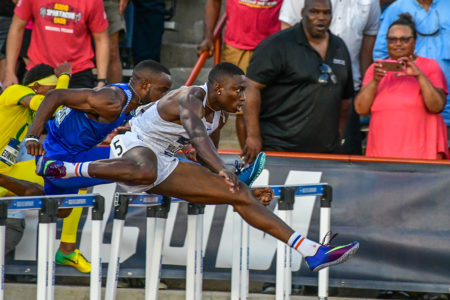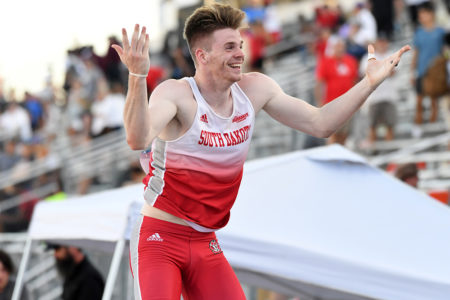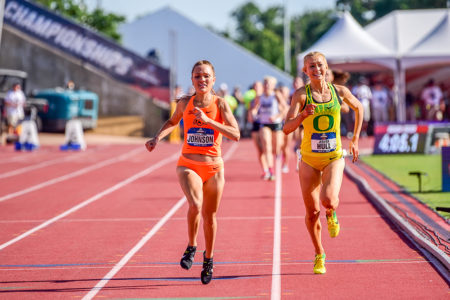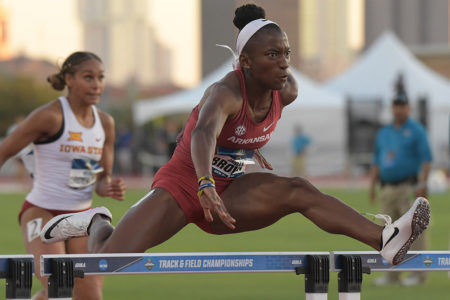
A HECKUVA DIFFERENCE a year can make: Sinclaire Johnson, whose stunning kick won the NCAA 1500 in the No. 2 collegiate time ever is the same Oklahoma Stater who finished last in her heat a year before. “That was pretty heartbreaking,” she says of her ’18 experience in Eugene. “Going in I thought I was going to do really well and definitely make first-team All-American.”
However, she was slammed by a severe allergy to cottonwood once she got to a town that is infamous for its pollen challenges. “It inhibited me from being able to breathe properly,” she says. “My face was just swollen and I was very, very miserable. By the time I got to the race on Thursday, I was just exhausted and I think that took a toll on me.” She finished 12th in her semi—dead last—in 4:27.72 after a season that had seen her lead the West Regionals in 4:11.57.
“After that I was definitely ready to get back out there and redeem myself because that was such a huge letdown to what was probably considered my breakout season,” she says. “I definitely wanted to come back and show everyone—and even myself too—that that race was not who I was as an athlete. I strive to be a lot better than that.”
Ironically, the commentators in Austin who talked about Jessica Hull’s unbeaten streak in the 1500 failed to note that the last collegian to beat Hull—at that ’18 West Regional—was Johnson. “She had some credibility going into this,” says Cowboy coach Dave Smith. “She’s pretty good.”
Johnson came a long way. She started running in 9th grade, when her mom came home from an athletic open house at Lake Brantley High School in Longwood, Florida, and suggested that running cross country might be a good conditioning plan for the then-lacrosse player. It wasn’t pretty at first, she admits: “I kid you not, I was probably running 10-minute miles. I could barely run 3M without stopping.” But she improved fast enough to qualify for the state finals that season: “The lightbulbs started going off in my parents’ heads. They said, ‘Maybe you should put down the lacrosse stick and pursue track.’” By the time she graduated, Johnson had clocked 2:08.71 and 4:59.00+. A 55.48 in the 400 offered evidence of her speed. She had won three State titles at 800 and two at 1600.
At Oklahoma State, under Smith’s coaching, she focused on the 2-lapper her first year, hitting just 2:10.95 and placing 7th in the Big 12. “Like a lot of kids,” explains Smith, “she had a tough transition. Her freshman year it was a little rough and her sophomore year, she missed indoors. I think she felt like, ‘I’m going to get serious and get this done and figure this out.’”
Johnson says, “I really lacked an aerobic base in high school. How I got recruited was my 800 and 400 times. But I knew going in that I was going to move up because most of the women who are in the same range I was in in high school have moved up to the mile and 1500. That was basically the plan. It was just a matter of when I would make that move. I think for the first year, Coach Dave just really wanted me to do something that I was comfortable with.”
In Stillwater, Johnson, an Econ & Finance major, started putting in the miles and developing an aerobic background. In ’17, she finished 28th in the Big 12 cross country. A year later she was the runner-up, and was the team’s top finisher at the NCAA.
Having put in a solid winter of training, Johnson focused this season on showing up big in Austin. A brief indoor season saw her anchor the Cowgirls to 3rd in the NCAA distance medley with a 4:30.22 for 1600. Outdoors, she won the 1500 at the Cardinal Classic in 4:13.35. At the Big 12, she took the 800 in 2:04.79. Once again she led the West Regional, this time in a PR 4:09.50.
“I think after Regionals, I knew I could run a lot faster, but I didn’t know exactly how much faster,” she says. She came to Austin knowing that she could go with any pace and that she would probably still have a stinging kick. “I’ve always known that I would be better suited for races that were sit-and-kick,” she explains. “It’s not necessarily something that we practice. It’s just something that has come naturally. I’ve found a way, whether I’m feeling good or feeling terrible, to find another gear. I try to push my kick as far as I can.”
Smith notes, “I tell them the most important part of the race is the last 50m. We talk about that and how a lot of people get excited and start going too hard too early and they get to the last 50 and they’re decelerating rapidly. Timing the kick is what’s important.”
The numbers on the board stunned the 21-year-old. “When I crossed the line and saw it, it really, really shocked me. More so to being able to do that in the conditions we were in—it was like 98-degrees [36.5C] on the starting line.”
Despite making the Doha standard, Johnson and Smith agree that shutting down the season is the right move. “The end goal for us was the NCAAs,” she explains. “After my race on Saturday, I think my mind was set on being done and I didn’t want to get too greedy and try to chase more and more times and possibly undo the magic of what happened this past weekend. I just want to end on a high note and take a little break and get ready for cross country season.”






